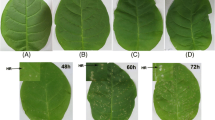Abstract
Following wounding of carrot (Daucus carota L.) roots, the activity of a nuclear factor (EGBF-1) that binds a 5′-region of the carrot extensin gene declines to undetectable levels within 48 h. Mixing of nuclear extracts from wounded roots with nuclear extracts from unwounded roots has demonstrated the existence of a wound-induced inhibitor of EGBF-1. Inhibition of EGBF-1 DNA-binding activity by nuclear extracts from wounded roots is shown to be specific for EGBF-1, and to be destroyed by heat treatment. In addition, inhibition is saturable and occurs rapidly. Active EGBF-1 can be reconstituted from its inhibited state by renaturation of proteins from mixed extracts following denaturation by boiling in sodium dodecyl sulfate and 2-mercaptoethanol, and electrophoretic separation, indicating that inhibition is dependent upon the reversible interaction of EGBF-1 with a titratable factor. However, EGBF-1 activity could not be detected in nuclear extracts from wounded roots following denaturation and electrophoretic separation. Inhibitory activity was not detectable in nuclear extracts from roots that had been trated with ethylene. The action of the inhibitor indicates one possible mechanism for the control of EGBF-1 activity in carrot roots following wounding.
Similar content being viewed by others
Abbreviations
- bp:
-
base pairs
- EGBF:
-
extensin-gene binding factor
- EMSA:
-
electrophoretic mobility-shift assay
- HRGP:
-
hydroxyproline-rich glycoprotein
- kDa:
-
kilodalton
- SDS:
-
sodium dodecyl sulfate
- UNE:
-
nuclear extracts from unwounded roots
- WNE:
-
nuclear extracts from wounded roots
References
Baeuerle, P.A., Baltimore, D. (1988a) Activation of DNA-binding activity in an apparently cytoplasmic precursor of the NF-k B transcription factor. Cell53, 211–217
Baeuerle, P.A., Baltimore, D. (1988b) IkB: a specific inhibitor of the NF-k B transcription factor. Science242, 540–546
Boulanger, P.A., Yoshinaga, S.K., Berk, A.J. (1987) DNA-binding properties and characterisation of Human Transcription Factor TFIIIC2. J. Biol. Chem.262, 15098–15105
Bradford, M.M. (1976) A rapid and sensitive method for the quantitation of microgram quantities of protein utilizing the principle of protein-dye binding. Anal. Biochem.72, 248–254
Chen, J., Varner, J.E. (1985) An extracellular matrix protein in plants: characterisation of a genomic clone for carrot extensin. EMBO J,4, 2145–2151
Cooper, J.B., Chen, J.A., Van Holst, G.J., Varner, J.E. (1987) Hydroxyproline-rich glycoproteins of plant cell walls. Trends Biochem. Sci.12, 24–27
Datta, N., Cashmore, A. (1989) Characterization of a pea nuclear factor binding to light regulated rbcS and CAB genes. J. Cell. Biochem. [Suppl.]13D, 317
Deikman, J., Fischer, R.L. (1988) Interaction of a DNA binding factor with the 5′-flanking region of an ethylene-responsive fruit ripening gene from tomato. EMBO J7, 3315–3320
Ecker, J.R., Davis, R.W. (1987) Plant defense genes are regulated by ethylene. Proc. Natl. Acad. Sci. USA84, 5202–5206
Galas, D.J., Schmitz, A. (1978) DNAse footprinting: a simple method for the detection of protein-DNA binding specificity. Nucleic Acids Res.5, 3157–3170
Giuliano, G., Pichersky, E., Malik, V.S., Timko, M.P., Scolnik, P.A., Cashmore, A.R. (1988) An evolutionarily conserved protein binding sequence upstream of a plant light-regulated gene. Proc. Natl. Acad. Sci. USA85, 7089–7093
Green, P.J., Kay, S.A., Chua, N.H. (1987) Sequence-specific interactions of a pea nuclear factor with light-responsive elements upstream of the rbcS-3A gene. EMBO J.6, 2543–2549
Green, P.J., Yong, M.H., Cuozzo, M., Kano-Murakami, Y., Silverstein, P., Chua, N.H. (1988) Binding site requirements for pea nuclear protein factor GT-1 correlate with sequences required for light-dependant transcriptional activation of therbcS-3A gene. EMBO J.7, 4035–4044
Holdsworth, M.J., Laties, G.G., (1989) Site-specific binding of a nuclear factor to the carrot extensin gene is influenced by both ethylene and wounding. Planta179, 17–23
Jensen, E.O., Marker, K.A., Schell, J., de Bruijn, J. (1988) Interaction of a nodule specific, trans-acting factor with distinct DNA elements in the soybean leghaemoglobinlbc 3 5′up-stream region. EMBO J.7, 1265–1271
Jofuku, K.D., Okamuro, J.K., Goldberg, R.B. (1987) Interaction of an embryo DNA binding protein with a soybean lectin gene upstream region. Nature328, 734–737
Laemmli, U.K. (1970) Cleavage of the structural proteins during assembly of the head of bacteriophage T4. Nature227, 680–685
Lee, C.Q., Miller, H.A., Schlichter, D., Dong, J.N., Wicks, W.D. (1988) Evidence for a cAMP-dependant nuclear factor capable of interacting with a specific region of a eukaryotic gene. Proc. Natl. Acad. Sci. USA85, 4223–4227
Maier, U.G., Brown, J.W.S., Schmitz, L.M., Schwall, M., Dietrich, G., Feix, G. (1988) Mapping of tissue-dependent and independent protein binding sites to the 5′upstream region of a zein gene. Mol. Gen. Genet.212, 241–245
Maniatis, T., Fritsch, E.F., Sambrook, J. (1982) Molecular cloning: a laboratory manual, Cold Spring Harbor Laboratory. Cold Spring Harbor, N.Y., USA
Mitchell, P.J., Wang, C., Tjian, R. (1987) Positive and negative regulation of transcription in vitro: enhancer binding protein AP-2 is inhibited by SV 40 T antigen. Cell50, 847–861
Oh-Lee, T.M., Turgeon, R., Wu, R. (1988) Interaction of a gibberellin-induced factor with the upstream region of an α-amylase gene in rice aleurone tissue. Proc. Natl. Acad. Sci. USA85, 6366–6369
Sen, R., Baltimore, D. (1986) Multiple nuclear factors interact with the immunoglobulin enhancer sequences. Cell46, 705–717
Singh, H., Sen, R., Baltimore, D., Sharp, D. (1986) A nuclear factor that binds to a conserved sequence motif in transcriptional control elements of immunoglobulin genes. Nature319, 154–158
Yoshinaga, S.K., L'Etoile, N.D., Berk, A.J. (1989) Purification and characterisation of Transcription Factor IIIC2. J. Biol. Chem.264, 10726–10731
Author information
Authors and Affiliations
Rights and permissions
About this article
Cite this article
Holdsworth, M.J., Laties, G.G. Identification of a wound-induced inhibitor of a nuclear factor that binds the carrot extensin gene. Planta 180, 74–81 (1989). https://doi.org/10.1007/BF02411412
Received:
Accepted:
Issue Date:
DOI: https://doi.org/10.1007/BF02411412




